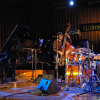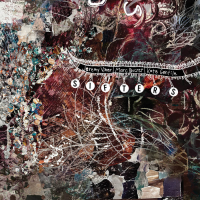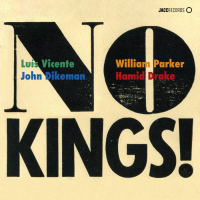Home » Jazz Articles » Album Review » Matthieu Bordenave: La Traversée
Matthieu Bordenave: La Traversée
Pianist Florian Weber, bassist Patrice Moret and Bordenave are a marvelous match. Each gravitating towards restraint rather than technical abandon, the three conjure quiet storms and loud meditations that share an eerie atmosphere as their foundation. Within it, unconventional motifs, of at turns atonal and traditionally harmonic constitution as well as unsettled structures, give way to unique amalgamations of interplay. While the early avant-gardist Jimmy Giuffre and his trio, featuring Steve Swallow and Paul Bley, does come to mind, Bordenave's influences seem to cut deeper into the repertoire of modern classical music, navigating even further away from archetypical swing, but maintaining its improvisatory candor.
Bordenave explains how, prior to recording and writing the album, he and Weber had talked about wanting to incorporate the colors of modern composition into their collaboration—the saxophonist being especially fond of 20th century French classical composers Olivier Messiaen and Henri Dutilleux. Messiaen's experiments with modes—often referred to as modes of limited transposition, as compiled in the organist and part-time ornithologist's book "La technique de mon langage musical"—particularly come to mind throughout the record. Like Messiaen's modes, Bordenave's sketch-like elaborations show rather uncommon scale anatomies with symmetrical pretense. The triangular intersections of single notes and chords each create unique spaces of their own in which melodies aspire to resolve wholesomely, even romantically, but instead vanish into a dissonant haze—still maintaining their elegant stride.
In the context of jazz music, dissonance often seems to appear in free improvisation and emerges on a whim, arbitrarily applied with the increase of tension being the only goal and chromaticism its main tool. This isn't the case with Bordenave's designs. With spontaneous allure, his scores appear strict and meticulously wrought. The improvisations follow suit. Weber and Moret are careful collaborators and apply their character gently by not simply framing Bordenave's haunting tenor but interacting with it as equals. In steady counterpoint, dry bass runs stumble into shrouded piano triads against obscure, yet calm tenor sustain— texture and tone being of equal importance throughout.
A prudent rapprochement between piano and saxophone, opening "River" is a duet that reveals the leader's humble intent in a dimly lit setting. The closer proves a very different reading of the same material in trio execution—the generous spaces between notes this time around crowded by interplay. Reminiscent of twelve-tone idioms, "Archipel"'s poetic verses are built around a few-note motif, whose dissonant sequencing is carried from bar to bar with derivatives built around. This fragmented approach can be traced across several instances on the album and helps define its haunting atmosphere.
Picking one highlight from the lot would go against the nature of the music, which presents itself as whole. Coming back to the Mosaic metaphor: what good would a piece of glass or ceramic do, without the remaining pieces drawing its context? And how does a river flow, if the current doesn't tug and pull the water from one place to another? Like a river, la Traversée unfolds like a mesmerizing journey, where each note and sound naturally lead to the next, as if inherently and eternally in transit. Or at least until its pool of inspiration dries up. But fortunately, there's no sign of that happening anytime soon.
Track Listing
River (duet); Archipel; Le temps Divisé; Dans mon Pays; The Path; Ventoux; Incendie Blanc; Chaleur Grise; River (trio).
Personnel
Album information
Title: La Traversée | Year Released: 2020 | Record Label: ECM Records
Tags
PREVIOUS / NEXT
Support All About Jazz
 All About Jazz has been a pillar of jazz since 1995, championing it as an art form and, more importantly, supporting the musicians who make it. Our enduring commitment has made "AAJ" one of the most culturally important websites of its kind, read by hundreds of thousands of fans, musicians and industry figures every month.
All About Jazz has been a pillar of jazz since 1995, championing it as an art form and, more importantly, supporting the musicians who make it. Our enduring commitment has made "AAJ" one of the most culturally important websites of its kind, read by hundreds of thousands of fans, musicians and industry figures every month.






















